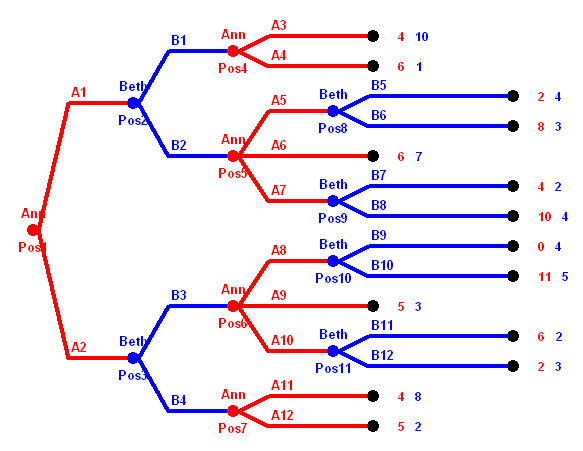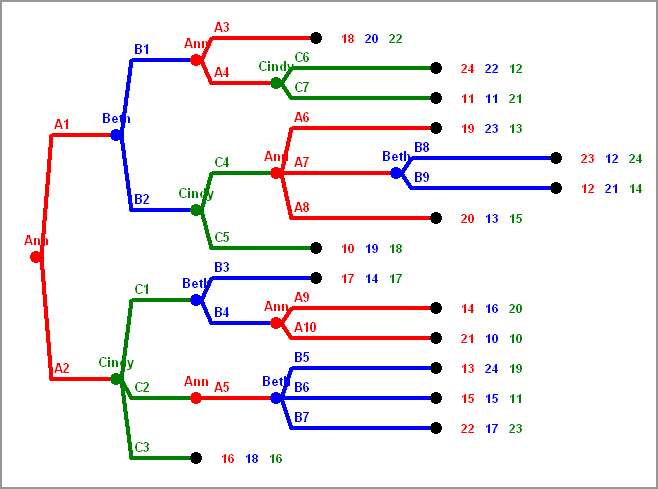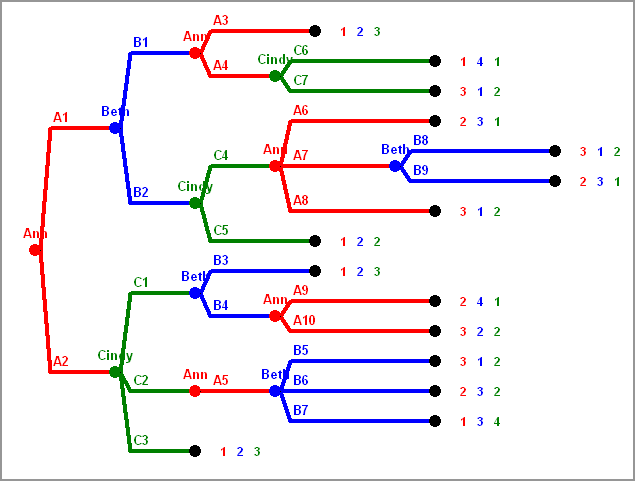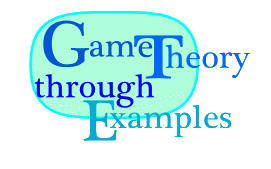TWO-ROUND BARGAINING(5,3):
Five dollar bills are to be shared by two players.
Ann makes an offer how to share them, which Beth can either accept or reject.
If she accepts, the bills are divided as agreed upon.
If the rejects, two dollar bills are taken away and only three remain on the desk.
Then Beth makes an offer how to share these three dollars,
which Ann can accept or reject. If Ann accepts, the bills are divided accordingly,
if she rejects, nobody gets anything.
Draw the extensive form of the game, and perform backward induction analysis.
Remember that you don't have to use a Game Tree---you can also use a digraph to simplify matters.
MATCHING CHAIRS:
Ann and Beth can select both 3 chairs out of 7 totally available chairs, two L-chairs
and five O-chairs. One L-chair is worth $300, but if you have a pair
of L-chairs, the pair is worth even $800. O-chairs are less valuable:
One is worth $100, a pair is worth $400, but three of them are worth $900.
Beginning with Ann, Ann and Beth alternate selecting a chair
until each of them has three.
Draw the extensive form of the game, and perform backward induction analysis.
 1:
1: 2:
2: 3:
3: 4:
4: 5:
5: 6:
6: 7:
7: 8:
8: 9:
9: 10:
10: 11:
11: 12:
12: 13:
13: 14:
14: 15:
15: 16:
16: 17:
17:
 1:
1: 2:
2: 3:
3: 4:
4: 5:
5: 6:
6: 7:
7: 8:
8: 9:
9: 10:
10: 11:
11: 12:
12: 13:
13: 14:
14: 15:
15: 16:
16: 17:
17:











There are three players, A, B, C. At the beginning A has a dollar note.
In each round the player having the dollar note has to give it to one of the other two players.
After 5 rounds, after the dollar note has moved 5 times, the game is over and the player having it can keep it.
There are three players, A, B, C. At the beginning B and C have one dollar note each.
In each round the player without dollar note can grab the dollar note from one of the other two players.
After 6 rounds the game is over and the player having a dollar note can keep it.
There are four players, A, B, C, and D, sitting in a cyclic order.
At the beginning A has a dollar note.
In each round the player having the dollar note has to give it to the player to the right, or to the
player sitting opposite, but not to the player sitting to the left.
After 6 rounds, after the dollar note has moved 6 times,
the game is over and the player having it can keep it.
CHOCOLATES In THE BOX (5):
There are four players, A, B, C, and D, sitting in a cyclic order.
At the beginning A holds a box containing 5 pieces of chocolate.
In each round the player having the box eats one (just one!) of the pieces of chocolate
and then has to give the box to the player to the right, or to the
player sitting opposite, but not to the player sitting to the left.
After 5 rounds, the chocolate is gone. The payoff for each player is the number
of pieces of chocolate he or she has eaten.
CHOCOLATES In THE BOX (6):
There are four players, A, B, C, and D, sitting in a cyclic order.
At the beginning A holds a box containing 6 pieces of chocolate.
In each round the player having the box eats one (just one!) of the pieces of chocolate
and then has to give the box to the player to the right, or to the
player sitting opposite, but not to the player sitting to the left.
After 6 rounds, the chocolate is gone. The payoff for each player is the number
of pieces of chocolate he or she has eaten.
5 PIRATES with hierarchy, tie means yes:
Five pirates with a strict hierarchy have to decide decide how to distribute 20 gold coins they have found.
They do it according to the following rules.
In each round the highest ranking pirate (left) has to propose a distribution of the coins.
This proposal is voted on, with the proposer voting too, and even deciding in case of a tie.
That implies that in case of only two pirates, the proposal will always win, and in case of four pirates,
the proposer needs only one of the others voting for the proposal.
If the proposal wins, everything is settled.
If not, the proposer is thrown into the water and dies, and the next round starts.
Assume that the pirates value their life worth 40 gold coins, and prefer throwing somebody overboard
if everything else is equal (are playing the "hostile" variant).
What would you propose if the bottle points on you and there are 2, 3, 4, or 5 pirates left?
5 PIRATES with hierarchy, tie means no:
Five pirates with a strict hierarchy have to decide decide how to distribute 20 gold coins they have found.
They do it according to the following rules.
In each round the highest ranking pirate (left) has to propose a distribution of the coins.
This proposal is voted on, with the proposer voting too. Different to the version in the
previous exercise, in case of a tie the proposal is rejected.
If the proposal wins, everything is settled.
If not, the proposer is thrown into the water and dies, and the next round starts.
Assume that the pirates value their life worth 40 gold coins, and prefer throwing somebody overboard
if everything else is equal (are playing the "hostile" variant).
What would you propose if the bottle points on you and there are 2, 3, 4, or 5 pirates left?
